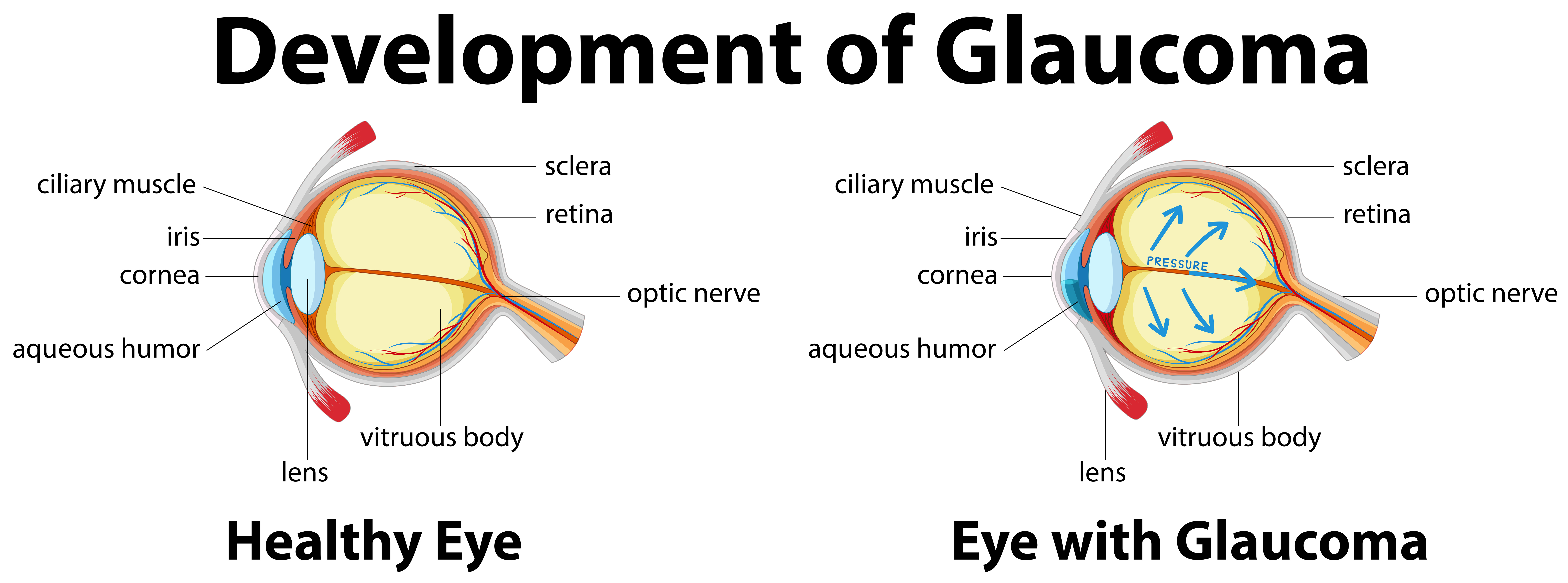Getting Diagnosed with Glaucoma: What to Expect from Testing
June 10, 2024
Glaucoma is one of the leading causes of blindness in individuals over the age of 60. It is often called "the silent thief of sight" because many people are not aware they have glaucoma until they start to experience some degree of visual impairment.
If you have been noticing problems with your vision, such as halos around lights, blurred vision, tunnel vision, or loss of peripheral vision, these could be signs of glaucoma. However, the only way to know is by scheduling an eye exam that includes diagnostic testing to diagnose glaucoma. Keep reading to learn what to expect from testing when getting diagnosed with glaucoma.
What is Glaucoma?
 Glaucoma is a group of eye conditions caused by damage to the optic nerve. Often, this damage results from elevated intraocular pressure.
Glaucoma is a group of eye conditions caused by damage to the optic nerve. Often, this damage results from elevated intraocular pressure.
The optic nerve is vital to clear vision. It sends visual information from the retina to the brain, using that knowledge to create the images you see.
While there are several types of glaucoma, the most common include the following:
Open-Angle Glaucoma
Open-angle glaucoma is the most commonly diagnosed type of glaucoma. It is caused by poor drainage of aqueous fluid from the eye.
Poor drainage of aqueous fluid from the eye leads to a gradual increase in the pressure within the eye and eventual damage to the optic nerve. Open-angle glaucoma usually develops slowly and may not cause noticeable symptoms until vision impairment or loss has occurred.
Angle-Closure Glaucoma
Angle-closure glaucoma occurs when the eye's drainage angle suddenly becomes blocked, leading to a rapid buildup of intraocular pressure. Often asymptomatic until an individual experiences an "acute attack," this type of glaucoma can cause sudden vision loss.
An acute attack of angle-closure glaucoma is a medical emergency that can cause permanent vision loss if not treated promptly.
Normal-Tension Glaucoma
People diagnosed with normal-tension glaucoma experience damage to their optic nerve despite having normal intraocular pressure. While the exact cause of normal-tension glaucoma is not fully understood, it is believed to be caused by factors like reduced blood flow to the optic nerve or an increased vulnerability to optic nerve damage.
Secondary Glaucoma
Secondary glaucoma is glaucoma that develops as a result of another eye or medical condition, including eye trauma, chronic eye inflammation, certain medications, and systemic diseases like diabetes.
Learn More About Glaucoma
What are the Tests Used for Diagnosing Glaucoma?
If your Eyes of York ophthalmologist suspects you may be developing glaucoma, they might perform the following tests:
Angle Eye Exam (Gonioscopy)
An angle eye exam, also known as a gonioscopy, evaluates the eye's drainage angle. Proper drainage of the eye's aqueous fluid is essential for maintaining healthy levels of intraocular pressure.
During this exam, your ophthalmologist will numb your eye and touch your cornea with a special lens. The lens shows whether the angle is open or closed. A blocked angle can be an indication of glaucoma.
Corneal Thickness Measurement (Pachymetry)
This test, also called pachymetry, checks the thickness of your cornea. Your ophthalmologist will numb your eye and touch it with a small probe. Individuals with thinner corneas may be at higher risk for glaucoma.
Dilated Eye Exam
A dilated eye exam helps your ophthalmologist get a closer, more comprehensive look at the structures within your eye. It allows them to examine your retina, optic nerve, and optic blood vessels more closely.
Your ophthalmologist will use special eye drops to dilate your pupil for this test. Then, they will use a special tool to shine a bright light into the back of your eye, magnifying the retina and optic nerve.
Eye Pressure Check
Tonometry, or an eye pressure check, assesses the pressure level within your eye. Increased ocular pressure is often a symptom of glaucoma.
During an eye pressure check, your ophthalmologist uses a tiny instrument to touch the surface of your eye, flattening the cornea and measuring intraocular pressure. This test is painless and takes just a few minutes to perform.
Optic Nerve Imaging
Optic nerve imaging is a non-invasive test using optical coherence tomography to create an image of the back of your eye. The image shows the thickness of your retina and optic nerve.
Optic nerve imaging creates three-dimensional images. This technology can track changes to the thickness of your retina and optic nerve over time.
Visual Field Test
Your ophthalmologist can perform a visual field test to evaluate how glaucoma affects your vision. This test determines whether you have lost vision in some regions of your field of vision.
For this test, your ophthalmologist will ask you to look straight ahead and ask if you can see an object in your peripheral field of vision. They may ask you to perform this test with one eye covered to test each eye individually.
The results of testing for glaucoma are usually immediate. If you are diagnosed with glaucoma, your Eyes of York ophthalmologist can explain your diagnosis, give you an idea of what to expect as the condition progresses, and advise you of your treatment options.
How is Glaucoma Treated?
Because the damage caused by glaucoma is irreversible, glaucoma treatments aim to reduce intraocular pressure and prevent further damage. The type of treatment your ophthalmologist recommends will depend on how far your glaucoma has progressed.
The first treatment they might try is medicated eye drops, which work by reducing aqueous fluid production or increasing drainage. Another early treatment is oral medications.
These medications attempt to lower intraocular pressure and are often combined with eye drops.
For more advanced glaucoma, laser therapy may help reduce the production of aqueous fluid and improve drainage. There are several laser therapies, and your ophthalmologist can determine which is right for you.
The best way to ensure that a glaucoma diagnosis doesn't lead to severe vision impairment is by scheduling regular comprehensive eye exams with your ophthalmologist at Eyes of York. Early diagnosis of glaucoma can protect your vision from this "silent thief of sight."
Do you have glaucoma? Get the treatment and information you need about this eye condition by requesting an appointment at Eyes of York in York, PA, today!



